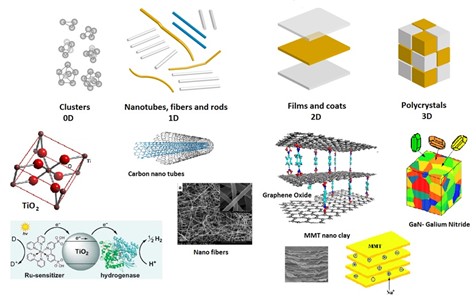Nowadays, various applications for nanoscience and nanotechnology have emerged in many fields including chemistry, biology, physics, and material science. The term ‘nano’ comes from the Greek word which means dwarf. Basically, nanoscience is the study of the properties and structures of materials on the scales of nanometers ranging between 1 and 100 nm whereas nanotechnology is the ability to manipulate and control these materials through separation, aggregation, and deformation of an atom or molecule. A nanometer is 60,000 times smaller than a diameter of a human hair. Nanomaterials structures can be characterized in one dimension (such as nanowires and nanotubes), two dimensions (such as thin films and nanosheets), or in all three dimensions (the combination of nanomaterials as polycrystals) as shown in Figure 1. Advances in nanoscience and nanotechnology have become important in a wide range of applications due to the two special properties of nanomaterials. First, nanoparticles have a larger surface area compared to the same amount of material produced in a wide-scale form. Nanomaterials have high reactivity, which improves the strength and electrical properties of the material. Another property of nanomaterials is the presence of quantum confinement. This confinement refers to the restriction of the motion of an electron to certain energy levels, causing the material bandgap to widen. Hence, it affects the electrical and magnetic properties of materials.

Figure 1: Difference structures of nanomaterials.
(Source: https://ninithi.wordpress.com/nanomaterials/)
Consumer products such as paints, construction materials, cosmetics, and medical treatment, as well as the food sector use nanotechnology-based components in some way. In medical treatment, nanoparticles are being used to transport drugs, heat, light, or other chemicals to specific cells, such as cancer cells. Particles have been designed to attract sick cells, allowing for direct treatment of those cells. This method helps to protect healthy cells in the body while also allowing for earlier illness diagnosis. Moreover, another good impact of nanotechnology is increasing the amount of wind-generated power. The blades of a windmill are constructed from epoxy incorporating carbon nanotubes. Carbon nanotubes are utilized in polymers and beton as composite fibres to enhance the thermal, mechanical, and electric properties of the bulk product. As a result, it improves windmill blade efficiency by making them more durable and lightweight. Nanotechnology is also useful in computing. Computers will be able to boot rapidly by using magnetic random access memory (MRAM) due to its nanometer-scale magnetic tunnel junctions, which may store data fast and effectively during a system shutdown.
Meanwhile, in Dowling et al. study, Fehrin et al. said “particles that have been finely split, such as titanium dioxide or carbon black, are more harmful compared to larger particles of the same material”. The presence of transition metals on the surfaces of particular types of nanoparticles might cause free radicals to be released in contact with body tissues. According to research on air pollution particles, scientists have observed that even non-toxic chemicals may cause toxic reactions in cells and organs when exposed to substantial doses in the nanometre size range of those substances.
In conclusion, the existence of nanoscience and nanotechnology has resulted in significant changes in human life. This advanced technology has both positive and negative impacts on the environment and human health. Hence, appropriate techniques must be established for assessing the toxicity of nanoparticulate chemicals in relation to the environment as well as human health.
References:
- Bayda, S., Adeel, M., Tuccinardi, T., Cordani, M., & Rizzolio, F. (2019). The History of Nanoscience and Nanotechnology: From Chemical–Physical Applications to Nanomedicine. Molecules, 25(1), 112. doi:10.3390/molecules25010112.
- Dowling, A. & Clift, Roland & Grobert, Nicole & Hutton, D. & Oliver, Raymond & O'Neill, Onora & Seaton, A.. (2004). Nanotechnologies: nanoscience and opportunities and uncertainties. London: R. Soc. R. Acad. Eng. Rep.. 61.
- Niranjani Chaurasia, "Nanotechnology and Nanomaterials in Everyday Life", International Journal of Science and Research (IJSR), https://www.ijsr.net/search_index_results_paperid.php?id=17041703, Volume 6 Issue 4, April 2017, 1560 – 1562.
- Marsh, Allison, "What is Nanotechnology?" (2012). Section 5: Imaging at the Nano Scale. 8. https://scholarcommons.sc.edu/imm_section5/8.
Written by:
Siti Najihah Darahim, Internship Student &
Dr. Ismayadi Ismail, Research Officer, Nanomaterials Synthesis and Characterization Laboratory (NSCL), ION2
Date of Input: 24/02/2022 | Updated: 24/02/2022 | roslina_ar
MEDIA SHARING























